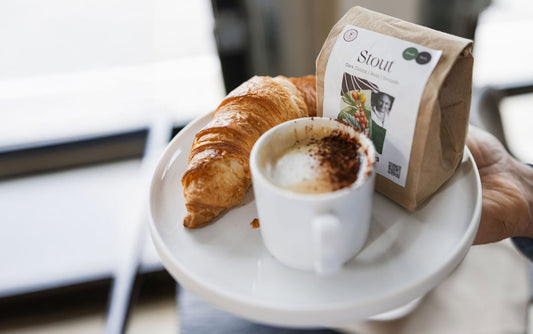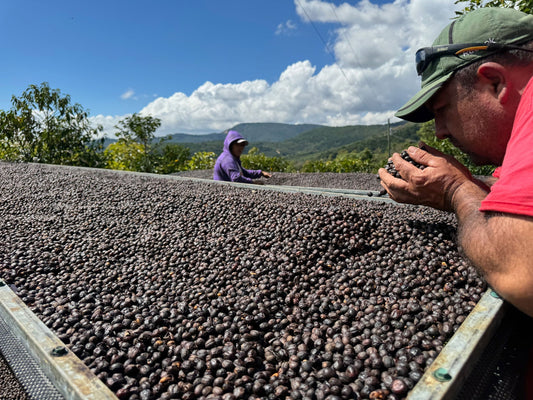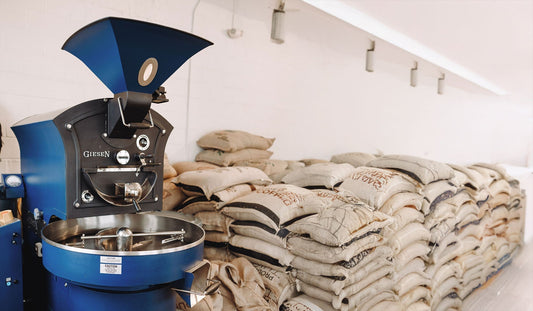In simple terms, that is what we mean when we talk about direct trade and fair trade coffee.
Done well, it also shifts power and profit closer to the people who grow the crop.

Done poorly, it is just a nice term on a bag.
Below we will explain what the reality looks like for smallholder farmers, what direct trade coffee actually means in practice, and how buying from a roaster that publishes and defends its sourcing choices can support farming families for the long term.
|
TL;DR When you buy from Ebru Coffee, you’re supporting direct trade relationships, fair and transparent FOB pricing set collaboratively, and fully traceable single-origin lots. All ensuring quality premiums go straight to the small farmers. Every purchase strengthens long-term partnerships, pre-harvest commitments, and real climate adaptation efforts at origin. |
The Reality For Smallholder Coffee Farmers Today
Smallholder farmers produce about 80 percent of the world’s coffee.
Depending on how you count, small farms produce a clear majority of global supply, with credible estimates landing between roughly sixty and eighty percent.

The Food and Agriculture Organization recently reiterated that smallholders account for about eighty percent of global coffee production.
Farmers Capture A Thin Slice Of The Retail Value
Despite carrying that load, farmers capture a thin slice of the value created along the chain.
A recent value chain study in Germany broke down where a consumer’s euro actually goes. Cultivation captures around one-fifth of the retail value, and the farmer’s net income in that example averaged only forty-one euro cents per kilogram of roasted coffee.
That is not a typo. Forty-one cents.
Climate Risk Raises The Stakes
Layer on climate risk, and the stakes get higher.
Peer-reviewed work indicates that the land suitable for arabica could shrink dramatically by mid-century, with global studies pointing to major losses in key regions by 2050.
If we want farmers to invest in adaptation, we need to pay prices that make that possible.
That is the backdrop. Now, here is what we can actually do about it when we talk about direct trade coffee.
What Direct Trade Coffee Actually Means
Direct trade is not a certification. There is no governing body that stamps a logo and audits it. It is a sourcing model where a buyer works directly with producers or producer groups.

Transparency And Long-Term Behavior
Because it lacks a standard or verifier, it lives or dies on real transparency and long-term behavior, not on a sticker.
The Minimum Facts That Prove It
In other words, if a roaster claims direct trade coffee but cannot show you basic facts like the producer’s name, the lot details, quality metrics,, you do not have much.
The Pledge And Comparable Reporting
A credible movement in specialty coffee called The Pledge sets a common code for publishing these variables so buyers and drinkers can compare apples to apples and hold claims to account.
Prices And Contract Terms Shape Livelihoods
Why does this matter for farmers in real life? Because prices and contract terms shape livelihoods.
What The Specialty Coffee Transaction Guide Shows
One of the best public data sets we have for specialty prices is the Specialty Coffee Transaction Guide, which aggregates tens of thousands of anonymized contracts each year.
The latest edition shows a median FOB price of three dollars and fifty cents per pound across specialty coffees in 2023 to 2024, with clear, predictable increases as cup quality rises and lot sizes shrink.
That is the level of price signal producers need to justify investing in quality.
Our Approach To Direct Trade At Ebru
We are a small roastery. That is exactly why we can be obsessive about relationships and details. Our approach is built around four pillars - coffee, community, climate, and culture.
Transparent Prices And Quality Metrics
We track quality scores, lot sizes, and FOB prices for the comparable coffees around the world, to ensure that we transact fairly and use all that data to guide the entire supply-chain process.
The reason is simple. Numbers beat adjectives.
When we benchmark offers against the Transaction Guide’s quality and lot size buckets, we can see whether a price recognizes the work required to deliver that cup score, and we can avoid hiding behind the commodity market when it has nothing to do with a microlot.
The guide’s data makes the pattern obvious. An eighty-six to eighty-seven point microlot under one thousand pounds had a median FOB price of four dollars and eighty-two cents last harvest year.
Containers of lower-scoring coffee were much cheaper. Quality and quantity both matter.
Multi-Year Relationships And Pre-Harvest Commitments
Farmers cannot plan fertilization, labor, or drying infrastructure on “vibes”.
They need predictability.
We work to extend relationships beyond a single harvest and, when possible, make commitments ahead of the pick so producers know there is a buyer for that lot if they meet the specs.
The sector’s own research on the recent price crisis underscores that long-term contracts and cost-aware pricing are part of the fix rather than chasing spot prices after harvest.
Paying For Quality, Not Buzzwords
We love a clean label as much as anyone, but labels alone do not pay school fees.
The Coffee Barometer shows that certified volume often exceeds certified demand, which means farmers can do the work and still sell at conventional prices.
We focus first on quality anchored contracts that pay on the merits of the lot and then layer on compliance where it actually adds value for producers.
That is how you avoid empty premiums.
Traceability That Serves Producers
Traceability is useful when it helps farmers get paid and reduces risk.
It is less useful when it is just a QR code for marketing. Reviews of digital traceability in agri food supply chains point out both the benefits and the drawbacks, especially the cost and complexity for smallholders.
We favor tools that keep producer data secure, meet legal requirements, and unlock better prices. Shiny ledgers alone do not.
How Your Purchase Translates Into Impact
A reasonable question is where a bag price goes and how that links back to the grower. There is no single global ratio because taxes, logistics, roasting yields, and wages vary by country.
First, roasted coffee loses weight during roasting.
Roasting causes roughly 15 to 20 percent weight loss, affecting how retail prices relate to FOB.
That matters when you calculate how much of your payment can reach the FOB stage. The Transaction Guide calls this out explicitly so consumers remember the physics involved.
What Your Purchase Actually Supports
When you buy from a roaster that treats direct trade coffee as a discipline rather than a phrase, you are doing three concrete things.
- You are rewarding producers and pros for quality with prices that move beyond the commodity market.
- You are funding long-term relationships so producers can plan ahead without worrying about immediate economic factors.
- You are voting for traceability that reduces risk and actually helps farmers sell the next crop at a fair price and improve multitude of things surrounding not just coffee, but their communities.
What To Look For If You Want Your Coffee To Support Farmers
- Producer Info: Who is the producer, and how long has the roaster worked with them?
- Cup Score & Grading: What’s the cup score and who graded it?
- Lot Size & Harvest Date: Ask for these details.
- FOB Price: Can they share the FOB price or range?
- Transparency: Check if they follow The Pledge for consistency and transparency.
- Climate Risk: How do they help farmers adapt to climate challenges?
When buying ethically sourced coffee, look for transparency in the sourcing process, such as the producer's name, lot size, harvest date, and cup score. If these details are provided, it’s a good sign that the coffee is ethically sourced and supports small farmers
Why Buying From Us Helps
Here, at Ebru Coffee, we are explicit about the kind of coffee we buy and why. We favor lots that can be traced to specific producers or communities.
We buy based on quality and stability, not hype. We benchmark price offers against independent data, not just against the commodity market.
We invest in relationships, training, and predictable volumes. When the numbers add up and the coffee is right, everyone wins, including you.
And yes, we also roast to express origin rather than hide it. Great coffee is the easiest way to keep a good pricing system alive.
If the cup does not deliver, no one buys it twice. That is the only marketing rule that truly matters in the long run.
Frequently Asked Questions
Does Direct Trade Replace Certifications?
No. Direct trade focuses on the relationship and agreed price for specific lots, while certifications set baseline standards. Both can work together but are not the same.
What Evidence Shows That Higher Prices Reach Farmers?
The Specialty Coffee Transaction Guide shows that when roasters pay above median prices for quality, more money stays with the farmer, especially with fair farmgate terms.
How Big Is The Climate Risk And Why Should I Care?
Climate change could reduce suitable land for Arabica by 2035. Farmers need income and support to adapt, which can be funded by quality-driven prices and improved varieties.
Is Single Origin Better For Farmers?
Single origin can be better if it's traceable to a specific community, with clear pricing and quality data. Transparency helps ensure fair compensation.
What If A Roaster Will Not Share Pricing?
Move on. Roasters who follow The Pledge share pricing data transparently, so avoid those who don’t.
Conclusion
By choosing direct trade coffee, you're directly supporting small farmers through transparent pricing, long-term relationships, and better quality-driven premiums.
This approach goes beyond certifications and ensures that your purchase makes a tangible impact, helping farmers adapt to climate risks, invest in their crops, and earn a fair income.
When you buy coffee that is ethically sourced and traceable, you're voting for a fairer, more sustainable coffee industry that benefits both the producer and the consumer.





